
219
3826

Back to the Racing Line with the Richard Mille RM028 at the Voiles de Saint Barth

[The bow of Varuna: the all black racing machine – a Ker 51 type yacht built by Knierim Yachtbau in Kiel]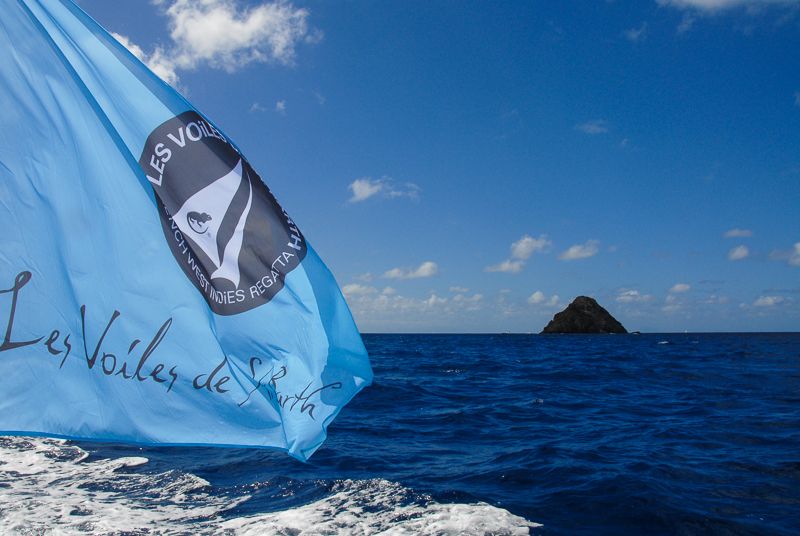
It was good to be back in the small French collectivity of Saint Barths (or Collectivité territoriale de Saint-Barthélemy to give it the official title). Four years ago (in 2010) I attended the inaugural Voiles de Saint Barth when it was a fledgling event and there were only 26 yachts taking part. (http://richardmille.watchprosite.com/show-forumpost/fi-18/pi-3802601/ti-606936/s-0/) Without Richard’s support, the regatta was lacking a sponsor and any form of momentum. Now the event is becoming a placeholder on the winter Caribbean yachting calendar. The fleet at the Voiles de Saint Barth 2013 had swollen up to 64 yachts, and unlike some of the neighbouring events (such as the “Buckets” in Antigua and Saint Barth), the Voiles welcomes yachts big and small, mono and multiple hull sailing craft. For one week out of the year, you cannot go anywhere in Saint Barths without seeing the Richard Mille sign by the roadside or the quai-side. The event takes over the island, and with it, the Richard Mille name becomes synonymous with Saint Barths.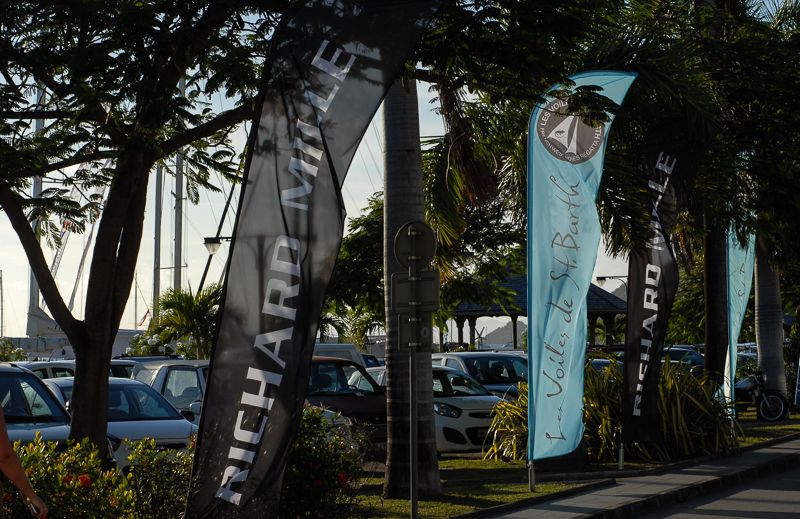
[Rue de la Republique, Gustavia, Saint Bathelemy: suitably decorated for the Voiles]
Saint Barthelemy is an idyllic place, but the sailing is hard, especially on the north side of the island where the Atlantic meets the trade winds that push the gulfstream north. You can be sailing along, no pun intended, and just as you think you are in for an easy day of relatively smooth sailing, the swell surrounds you and without the GPS, keeping an eye on the horizon is difficult with waves taller than you are.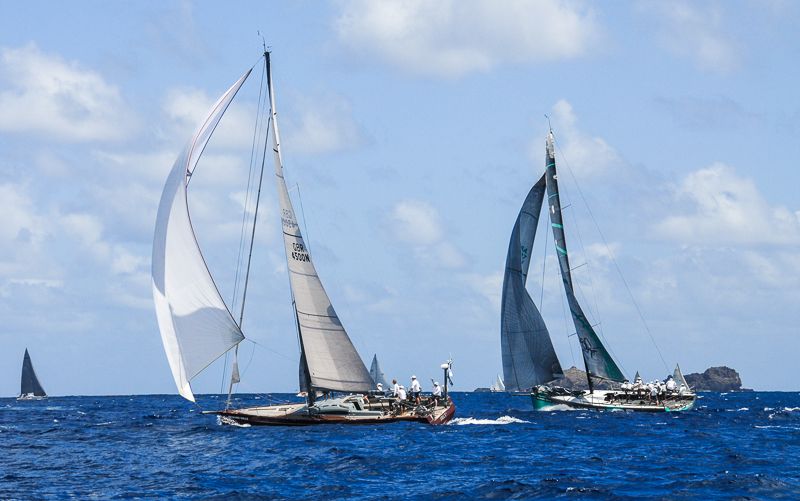
[Vesper cuts away from JOLT2 to catch the wind]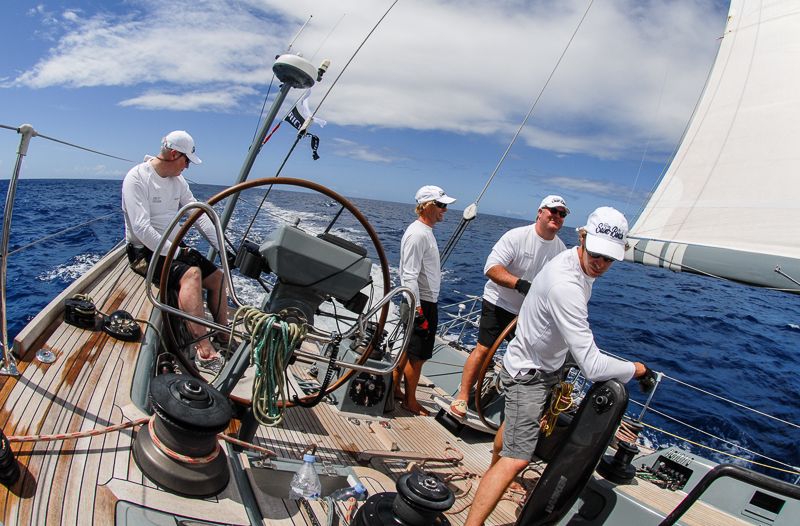
Timing is always present in yachting. Any navigation requires minutes and seconds, the start is a countdown shadow boxing exercise in nerves: the six-minute warning, the one-minute gun, and the start. Be at the line, not across it; make sure you have the wind, and make sure your opponents do not; watch for the tack or jibe. The time to the next marker, the time from your opponent(s) making the same turn, and the time at the finish. You need precision timing. You need precision timing in a watch that can take the punishment that sailing brings to human limbs and yachting equipment and keep ticking.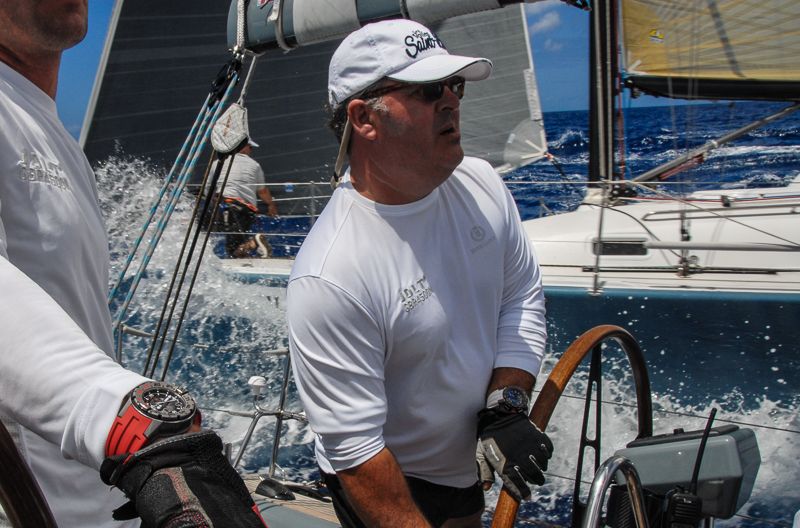
[Peter Harrison at the helm of JOLT2 – and wearing the RM032!]
This year I was back at the Voiles racing on Peter Harrison’s yacht: JOLT2. Not the Peter Harrison (who owns and races Sojana), but the smarter and younger Peter Harrison who is the General Manager of Richard Mille EMEA. A keen experienced sailor and getting into racing, this was his first foray into the event. The yacht we were sailing on: JOLT2 is a custom ‘state of the art ‘one-off racing yacht, built of carbon fibre, designed by Reichel Pugh (San Diego) as a ‘downwind sled’ and built in 2009 by Baltic Yachts of Finland. Peter Harrison has been racing JOLT2 since 2012. Although JOLT2 has competed in the sister regatta: Les Voiles de St Tropez in 2012, this was the first time at Les Voiles de Saint-Barth. JOLT2 competed in the category: Spinnaker 1. The crew were a motley bunch: comprising of some professional and keen amateur sailors, as well as some landlubber journalists (of which I count myself among their number).
[Part of the necessary equipment for yachting: an accurate timekeeper]
Along with the crew kit, we were also testing the Richard Mille watches in the event. Most of us were issued with RM028 watches; Peter Harrison was wearing the RM032 chronograph. Someone had to keep track of the start gun countdown! I had the chance to wear the RM028 Voiles de Saint Barth watch and I have to admit to it being my favourite iteration of the RM028 watches. Last time I was at the event, the watch only existed in computer rendered form, but this time, it was the watch on my wrist. Put a smile on my face! Wearing the watch, out on the racing line again at the Voiles de Saint Barth, sun on my face, the wind at my back: halcyon days to my mind. 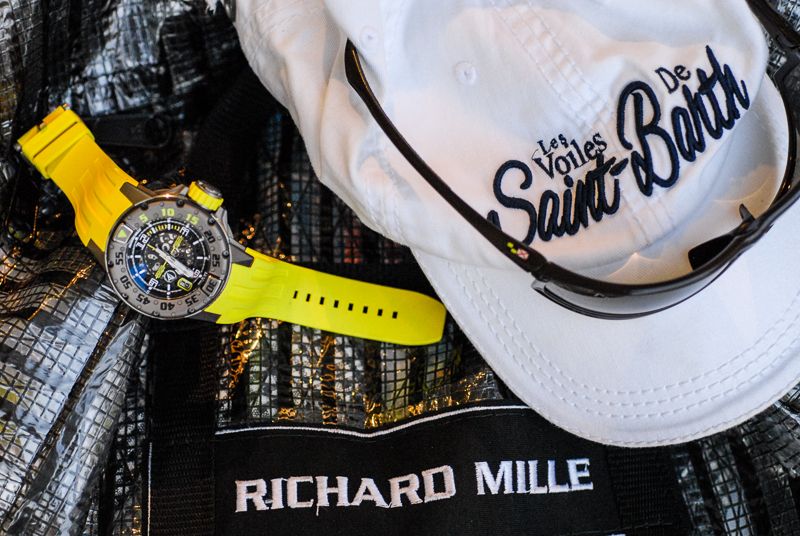
[The RM028 Voiles de Saint Barth, cap, sailing glasses, and the Richard Mille crew kit bag (made out of old sail material)]
Probably more by default than by design, the diver watch has also become the watch that is all things nautical to Richard Mille. The design of the trophy for the Voiles de Saint Barth certainly indicates as much, and the design elements that make up the RM Diver case can to be found in the crystal trophy that goes to the overall winner. This year, with George David and his yacht: Rambler taking a break from the competition, the trophy will have a new name on it for the first time. 
The RM028 case came about as an evolution. When Richard started to think about a diver watch he initially started with the tonneau design that had (and to some extent still is) a trademark design. However, what started out as a wish to design a tonneau shaped diver watch, morphed into a round watch series for Richard. I asked Richard what happened to the tonneau design: “…the result was too ugly!” came the reply. Ever the man for aesthetics as well as the highest technical specifications, the design just did not look good! So the round Richard Mille design was born.
However, where a round watchcase might be ordinary, and on the roster of every watch manufacturer on the planet, for Richard Mille there is the need to deliver the technical specifications and ensure that the watch is unique. Sure, the Richard Mille dive watch adheres to the ISO norm 6425, and can survive in water up to 300 metres deep, but that does not tell you the extent to which the watch has to stand up to stresses and strains on or under the ocean’s waves. The ISO 6425 actually does have content. As well as expected visibility and running requirements, the ISO standard stipulates that there has to be a shock resistance test, a chemical resistance (specifically to solutions such as sea water!), and a strap solidity (at 200N to each strap end) to ensure the watch will stay on the wrist. If the watch does receive a sideways hit, it not only keeps working, but will also stay on the wrist. In short, you have to demonstrate that the watch can withstand some unrelenting conditions. The type of conditions found on a yacht during racing.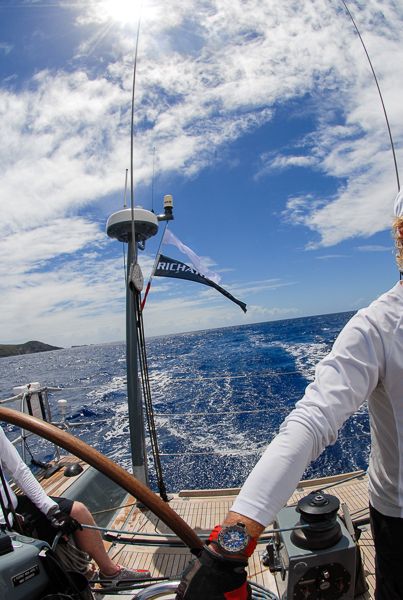
To the ISO standards add in Richard’s own wish list of what a watch case should be and attain, and the Richard Mille diver’s watch (RM028) soon became one of the more complex but toughest watch cases on the market. Once the decision had been taken in favour of the round case, Richard became devoted to producing the highest quality technical design for a diver’s watch. The case is still a tri-part case: a base, middle, and top. To the top part of the case, Richard designed and fixed a complex uni-directional rotating bezel that requires (as a significant safety feature) both push buttons to be active simultaneously to rotate. Added to the case complexity was a set of lugs (that have to be screwed onto the case) that had to both withstand the ISO strap solidity test, but also had to add to the ergonomics of the case in fitting the wrist. Richard summed it up succinctly: “Beside the parameters explained before, one of the main elements was the ergonomy: not easy to get on with such a big case. To my eyes, it is of utmost importance that such a tool fits well on the wrist!” And it does, for a case size that is 47mm, the watch has the customary feel of the Richard Mille watch as it melds to your wrist.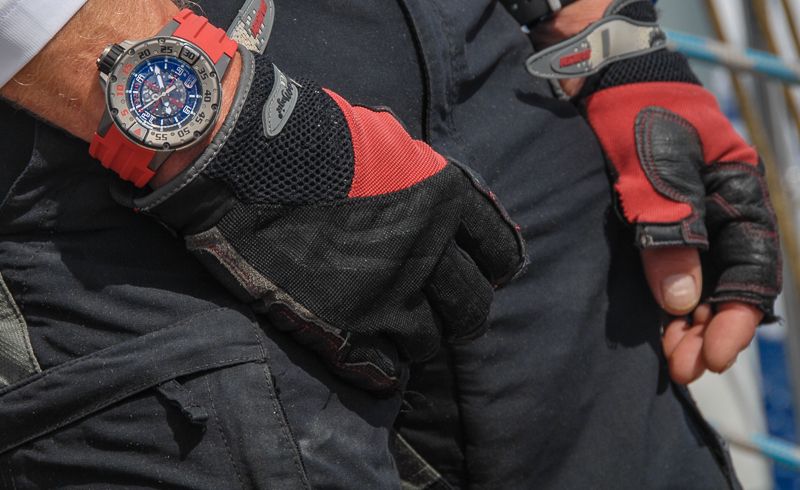
The case requires a mind boggling 22 torque screws (especially designed for the diver’s watch case) to hold the case together, the bezel, and the lugs. Recently, after losing the main case supplier through acquisition by a luxury group, Richard moved case making in house to his own facility. This has been something of a bonus and a headache; Richard can now fully control the quality for the RM028/032 case, but this has entailed getting the manufacturing process up to scratch. Speaking about the RM028 and RM032 watches, and everything that has been and is required to manufacture the watches, Richard was effusive in his description of the dive watches: “… we need to ensure the extraordinary level of the manufacturing process. A real piece of technique and art. Honestly speaking, I have not seen anywhere a technical case of that kind.”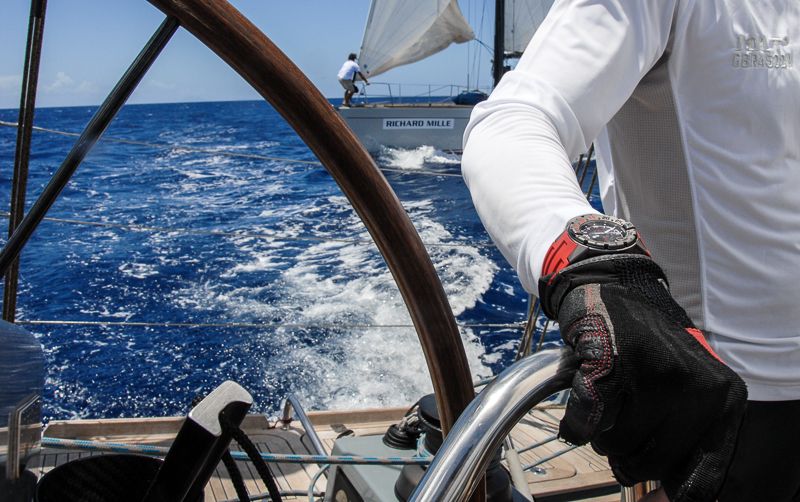
The movement inside the case is the Richard Mille automatic (RMAS7) – made to design for Richard by Vaucher - with the variable geometry rotor. As before the rotors white gold ‘wings’ can be adjusted depending on the degree of activity in sailing. The movement contains an incabloc escapement to guard against shocks (that might not dent the case structure) but would ordinarily affect timekeeping. And if you should find yourself in the water, and 300 metres down, then you can still find your RM028 ticking (even if you are not!). 
While Saint Barths has become a place synonymous with the ‘playground of the well heeled’, for the Voiles it becomes the ‘playground of the well keeled’. Racing in the Voiles de Saint Barth is testing. Even the race organizers think it’s tough, and as there were some individuals last year who felt the racing should be harder (are they out of their minds?), this year the requirements on sailing and sailors was that much tougher. 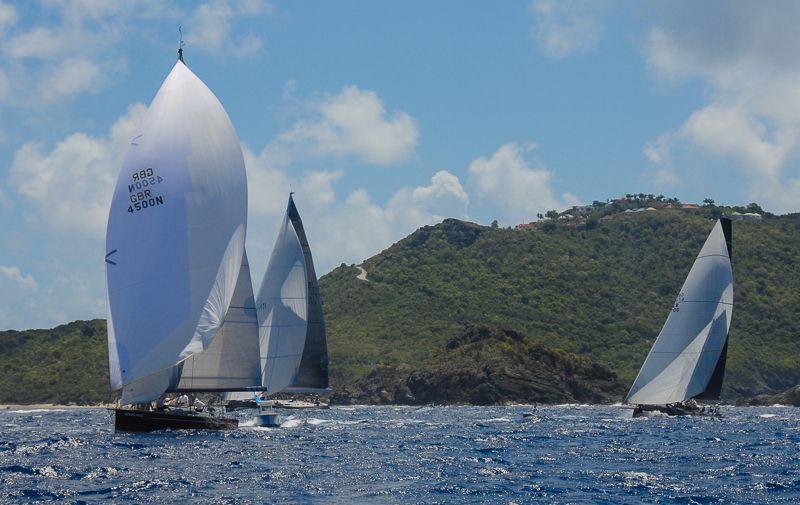
Annelisa Gee (one of the Voiles de Saint Barths organisers) described it as being a Grand Prix for yachts: “… this is not one of those festivals where the guys are lying with their tops off trying to catch the sun. The racing course requires a huge amount of skill and there is a lot of opportunity for error.” To ensure that the Voiles de Saint Barth has grown as an event in the packed Caribbean yachting calendar, the organizers had to carve out a niche. So in keeping with Richard’s own mantra, the Voiles de Saint Barth became an event that symbolized extremely competitive sailing with luxury amenities. And then, almost as if quoting from the Richard Mille ‘playbook’, Annelisa Gee added: “.. the sailing teams taking part are of excellent quality, and every year there are always new models with the latest racing technology.”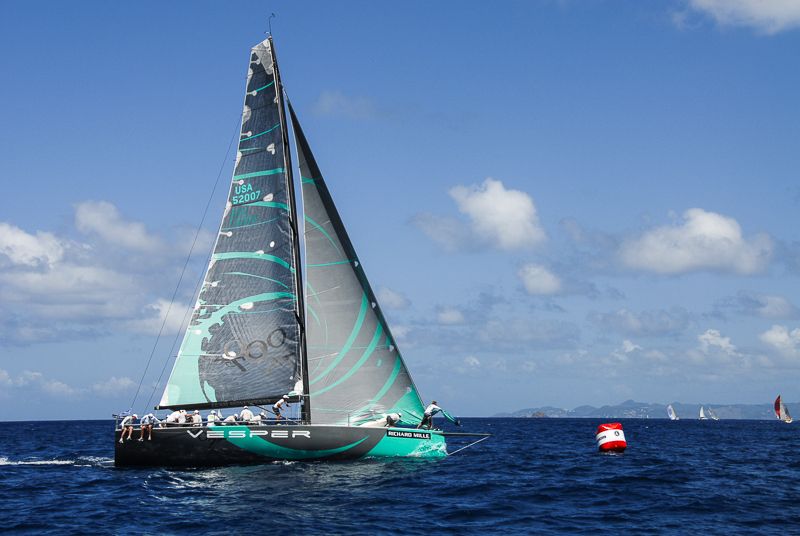
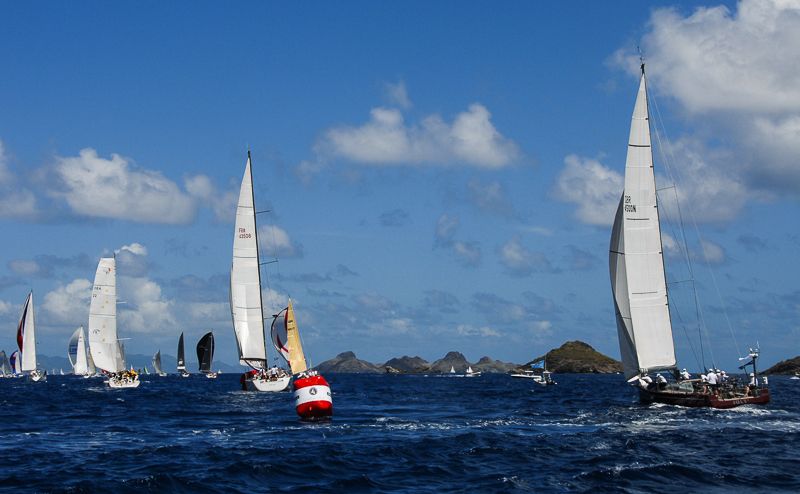
[JOLT2 rounds the buoy and hoists the spinnaker]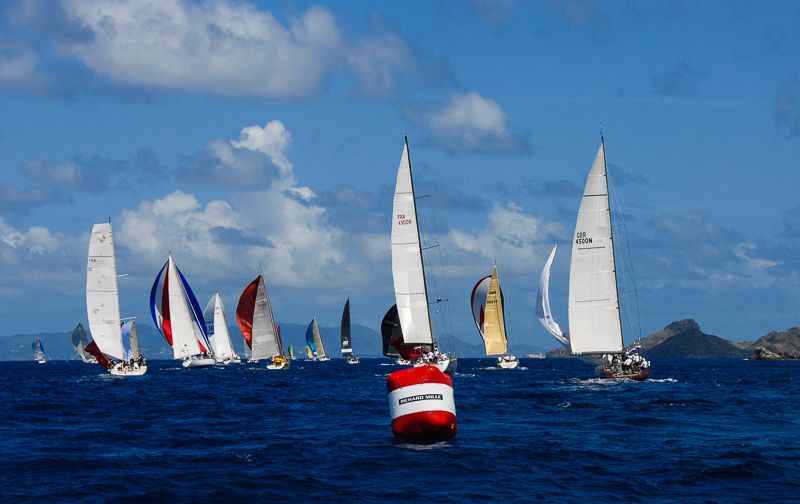
[The regatta heads off down wind]
Depending on where you are in terms of the seas off the island, the wind speed can vary from 5 to 25 knots (or somewhere between 6 to 30 miles an hour). Racing downwind, the yachts with their spinnakers aloft, the regatta was a wonderful sight. The wind is continuous, but not in a consistent pattern. There are eddies and flows; catch a gust of wind and you can pass others in front of you. There are now six classes of yachts in the Voiles de Saint Barth, and because the speed of the yachts varies, the starts are all staggered. Obviously, slowest first; fastest (and that would be the multi-hull yachts) go off last. 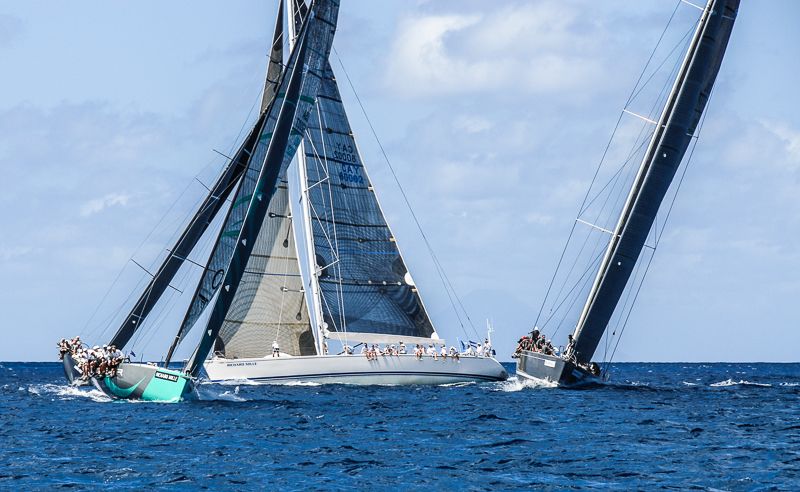
[Vesper to the left, Varuna to the right, Celene about to tack in the middle]
The Voiles de Saint Barth will be back next year; Richard has already confirmed he will be there too; the fifth year that Richard Mille will have been the main sponsor of the event. As seemingly in all he does, Richard takes a fledgling event/idea and helps make it successful; he has a knack of doing that. So next year, an even larger regatta will be back to the racing line around Saint Barthelemy once again. Can only hope, with the RM028 on my wrist that I am there!
Andrew H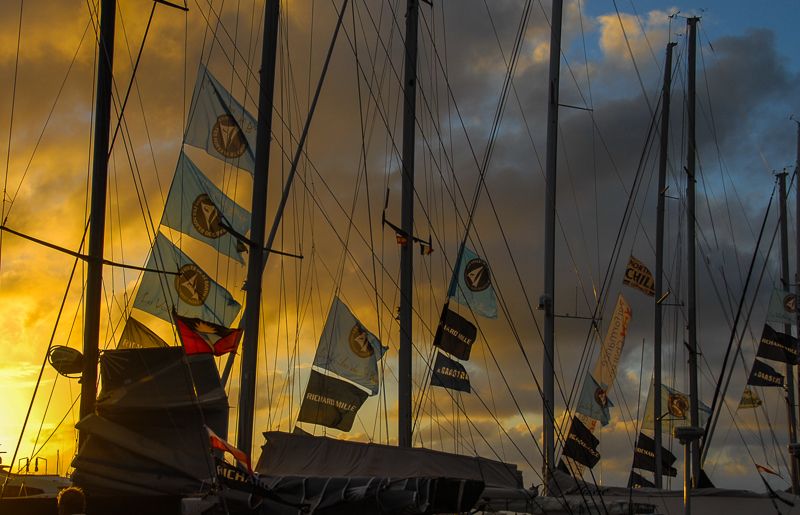
===
To leave comments, please go to Andrew's original post in RM forum, richardmille.watchprosite.com
